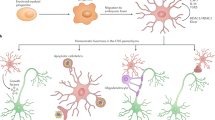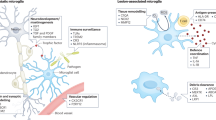Abstract
Although microglial activation occurs in inflammatory, degenerative and neoplastic central nervous system (CNS) disorders, its role in pathogenesis is unclear. We studied this question by generating CD11b-HSVTK transgenic mice, which express herpes simplex thymidine kinase in macrophages and microglia. Ganciclovir treatment of organotypic brain slice cultures derived from CD11b-HSVTK mice abolished microglial release of nitrite, proinflammatory cytokines and chemokines. Systemic ganciclovir administration to CD11b-HSVTK mice elicited hematopoietic toxicity, which was prevented by transfer of wild-type bone marrow. In bone marrow chimeras, ganciclovir blocked microglial activation in the facial nucleus upon axotomy and repressed the development of experimental autoimmune encephalomyelitis. We conclude that microglial paralysis inhibits the development and maintenance of inflammatory CNS lesions. The microglial compartment thus provides a potential therapeutic target in inflammatory CNS disorders. These results validate CD11b-HSVTK mice as a tool to study the impact of microglial activation on CNS diseases in vivo.
This is a preview of subscription content, access via your institution
Access options
Subscribe to this journal
Receive 12 print issues and online access
$209.00 per year
only $17.42 per issue
Buy this article
- Purchase on Springer Link
- Instant access to full article PDF
Prices may be subject to local taxes which are calculated during checkout





Similar content being viewed by others
References
Kreutzberg, G.W. Microglia: a sensor for pathological events in the CNS. Trends Neurosci. 19, 312–318 (1996).
Weiner, H.L. & Selkoe, D.J. Inflammation and therapeutic vaccination in CNS diseases. Nature 420, 879–884 (2002).
Carson, M.J. Microglia as liaisons between the immune and central nervous systems: functional implications for multiple sclerosis. Glia 40, 218–231 (2002).
Becher, B., Prat, A. & Antel, J.P. Brain-immune connection: immuno-regulatory properties of CNS-resident cells. Glia 29, 293–304 (2000).
Ambrosini, E. & Aloisi, F. Chemokines and glial cells: a complex network in the central nervous system. Neurochem. Res. 29, 1017–1038 (2004).
Ulvestad, E. et al. Human microglial cells have phenotypic and functional characteristics in common with both macrophages and dendritic antigen-presenting cells. J. Leukoc. Biol. 56, 732–740 (1994).
Schwartz, M. & Moalem, G. Beneficial immune activity after CNS injury: prospects for vaccination. J. Neuroimmunol. 113, 185–192 (2001).
Kerschensteiner, M., Stadelmann, C., Dechant, G., Wekerle, H. & Hohlfeld, R. Neurotrophic cross-talk between the nervous and immune systems: implications for neurological diseases. Ann. Neurol. 53, 292–304 (2003).
Dziennis, S. et al. The CD11b promoter directs high-level expression of reporter genes in macrophages in transgenic mice [published erratum appears in Blood 1995 Apr 1;85(7):1983]. Blood 85, 319–329 (1995).
Fyfe, J.A., Keller, P.M., Furman, P.A., Miller, R.L. & Elion, G.B. Thymidine kinase from herpes simplex virus phosphorylates the new antiviral compound, 9-(2-hydroxyethoxymethyl)guanine. J. Biol. Chem. 253, 8721–8727 (1978).
Culver, K.W. et al. In vivo gene transfer with retroviral vector-producer cells for treatment of experimental brain tumors. Science 256, 1550–1552 (1992).
Bush, T.G. et al. Fulminant jejuno-ileitis following ablation of enteric glia in adult transgenic mice. Cell 93, 189–201 (1998).
Herraiz, M. et al. Liver failure caused by herpes simplex virus thymidine kinase plus ganciclovir therapy is associated with mitochondrial dysfunction and mitochondrial DNA depletion. Hum. Gene Ther. 14, 463–472 (2003).
Braun, R.E. et al. Infertility in male transgenic mice: disruption of sperm development by HSV-tk expression in postmeiotic germ cells. Biol. Reprod. 43, 684–693 (1990).
Fisher, R.C., Lovelock, J.D. & Scott, E.W. A critical role for PU.1 in homing and long-term engraftment by hematopoietic stem cells in the bone marrow. Blood 94, 1283–1290 (1999).
Okabe, M., Ikawa, M., Kominami, K., Nakanishi, T. & Nishimune, Y. 'Green mice' as a source of ubiquitous green cells. FEBS Lett. 407, 313–319 (1997).
Hickey, W.F. & Kimura, H. Perivascular microglial cells of the CNS are bone marrow-derived and present antigen in vivo. Science 239, 290–292 (1988).
Eglitis, M.A. & Mezey, E. Hematopoietic cells differentiate into both microglia and macroglia in the brains of adult mice. Proc. Natl. Acad. Sci. USA 94, 4080–4085 (1997).
Priller, J. et al. Targeting gene-modified hematopoietic cells to the central nervous system: use of green fluorescent protein uncovers microglial engraftment. Nat. Med. 7, 1356–1361 (2001).
Asheuer, M. et al. Human CD34+ cells differentiate into microglia and express recombinant therapeutic protein. Proc. Natl. Acad. Sci. USA 101, 3557–3562 (2004).
Pedchenko, T.V. & LeVine, S.M. IL-6 deficiency causes enhanced pathology in Twitcher (globoid cell leukodystrophy) mice. Exp. Neurol. 158, 459–468 (1999).
Raivich, G. et al. Immune surveillance in the injured nervous system: T-lymphocytes invade the axotomized mouse facial motor nucleus and aggregate around sites of neuronal degeneration. J. Neurosci. 18, 5804–5816 (1998).
Sasaki, Y., Ohsawa, K., Kanazawa, H., Kohsaka, S. & Imai, Y. Iba1 is an actin-cross-linking protein in macrophages/microglia. Biochem. Biophys. Res. Commun. 286, 292–297 (2001).
Lassmann, H., Bruck, W. & Lucchinetti, C. Heterogeneity of multiple sclerosis pathogenesis: implications for diagnosis and therapy. Trends Mol. Med. 7, 115–121 (2001).
Youssef, S. et al. The HMG-CoA reductase inhibitor, atorvastatin, promotes a Th2 bias and reverses paralysis in central nervous system autoimmune disease. Nature 420, 78–84 (2002).
Steinman, L., Martin, R., Bernard, C., Conlon, P. & Oksenberg, J.R. Multiple sclerosis: deeper understanding of its pathogenesis reveals new targets for therapy. Annu. Rev. Neurosci. 25, 491–505 (2002).
Tran, E.H., Hoekstra, K., van Rooijen, N., Dijkstra, C.D. & Owens, T. Immune invasion of the central nervous system parenchyma and experimental allergic encephalomyelitis, but not leukocyte extravasation from blood, are prevented in macrophage-depleted mice. J. Immunol. 161, 3767–3775 (1998).
Martiney, J.A. et al. Prevention and treatment of experimental autoimmune encephalomyelitis by CNI-1493, a macrophage-deactivating agent. J. Immunol. 160, 5588–5595 (1998).
Benveniste, E.N. Role of macrophages/microglia in multiple sclerosis and experimental allergic encephalomyelitis. J. Mol. Med. 75, 165–173 (1997).
Becher, B., Durell, B.G., Miga, A.V., Hickey, W.F. & Noelle, R.J. The clinical course of experimental autoimmune encephalomyelitis and inflammation is controlled by the expression of CD40 within the central nervous system. J. Exp. Med. 193, 967–974 (2001).
Becher, B., Durell, B.G. & Noelle, R.J. IL-23 produced by CNS-resident cells controls T cell encephalitogenicity during the effector phase of experimental autoimmune encephalomyelitis. J. Clin. Invest. 112, 1186–1191 (2003).
Willenborg, D.O., Staykova, M.A. & Cowden, W.B. Our shifting understanding of the role of nitric oxide in autoimmune encephalomyelitis: a review. J. Neuroimmunol. 100, 21–35 (1999).
Flugel, A. et al. Migratory activity and functional changes of green fluorescent effector cells before and during experimental autoimmune encephalomyelitis. Immunity 14, 547–560 (2001).
Ford, A.L., Goodsall, A.L., Hickey, W.F. & Sedgwick, J.D. Normal adult ramified microglia separated from other central nervous system macrophages by flow cytometric sorting. Phenotypic differences defined and direct ex vivo antigen presentation to myelin basic protein-reactive CD4+ T cells compared. J. Immunol. 154, 4309–4321 (1995).
Matyszak, M.K. et al. Microglia induce myelin basic protein-specific T cell anergy or T cell activation, according to their state of activation. Eur. J. Immunol. 29, 3063–3076 (1999).
Ekdahl, C.T., Claasen, J.H., Bonde, S., Kokaia, Z. & Lindvall, O. Inflammation is detrimental for neurogenesis in adult brain. Proc. Natl. Acad. Sci. USA 100, 13632–13637 (2003).
Monje, M.L., Toda, H. & Palmer, T.D. Inflammatory blockade restores adult hippocampal neurogenesis. Science 302, 1760–1765 (2003).
Marin-Teva, J.L. et al. Microglia promote the death of developing Purkinje cells. Neuron 41, 535–547 (2004).
Mansour, S.L., Thomas, K.R. & Capecchi, M.R. Disruption of the proto-oncogene int-2 in mouse embryo-derived stem cells: a general strategy for targeting mutations to non-selectable genes. Nature 336, 348–352 (1988).
Heppner, F.L. et al. Prevention of Scrapie Pathogenesis by Transgenic Expression of Anti-Prion Protein Antibodies. Science 294, 178–182 (2001).
Black, M.E., Newcomb, T.G., Wilson, H.M. & Loeb, L.A. Creation of drug-specific herpes simplex virus type 1 thymidine kinase mutants for gene therapy. Proc. Natl. Acad. Sci. USA 93, 3525–3529 (1996).
Hailer, N.P., Heppner, F.L., Haas, D. & Nitsch, R. Astrocytic factors deactivate antigen presenting cells that invade the central nervous system. Brain Pathol. 8, 459–474 (1998).
Heppner, F.L., Roth, K., Nitsch, R. & Hailer, N.P. Vitamin E induces ramification and downregulation of adhesion molecules in cultured microglial cells. Glia 22, 180–188 (1998).
Heppner, F.L., Skutella, T., Hailer, N.P., Haas, D. & Nitsch, R. Activated microglial cells migrate towards sites of excitotoxic neuronal injury inside organotypic hippocampal slice cultures. Eur. J. Neurosci. 10, 3284–3290 (1998).
Miranda, K.M., Espey, M.G. & Wink, D.A. A rapid, simple spectrophotometric method for simultaneous detection of nitrate and nitrite. Nitric Oxide 5, 62–71 (2001).
Ellison, A.R. & Bishop, J.O. Herpesvirus thymidine kinase transgenes that do not cause male sterility are aberrantly transcribed and translated in the testis. Biochim. Biophys. Acta 1442, 28–38 (1998).
Acknowledgements
We thank D.G. Tenen for providing Itgam-Thy1-hGH cDNA, T. Bush for supplying GFAP-HSVTK control brains, C. Weissmann for discussion, J. Weber, P. Schwarz, A. Schifferli, M. König for technical assistance and C. Sigurdson for critical comments on the manuscript. This work is supported by grants of the Bundesamt für Bildung und Wissenschaft (EU), the Swiss National Foundation, the US National Prion Research Program, and the National Center of Competence in Research (NCCR) on neural plasticity and repair to A.A. F.L.H. was supported by the Human Frontier Science Program (HFSP), the Stammbach and the Leopoldina foundations. M.G. is a fellow of the Roche Research Foundation of Switzerland. B.B. is a Harry Weaver Neuroscience Scholar of the US National Multiple Sclerosis Society (NMSS).
Author information
Authors and Affiliations
Corresponding author
Ethics declarations
Competing interests
The authors declare no competing financial interests.
Supplementary information
Supplementary Fig. 1
GCV-mediated myelotoxicity of tg620 mice. (PDF 209 kb)
Supplementary Fig. 2
Intact blood-brain barrier of tg620chi mice. (PDF 1607 kb)
Supplementary Fig. 3
Reduced microglial numbers in tg620chi mice upon chronic GCV treatment. (PDF 56 kb)
Supplementary Fig. 4
GCV-mediated inhibition of microglial activation in brain slices of tg620 mice. (PDF 65 kb)
Supplementary Fig. 5
tg620 and wild-type mice exhibit similar EAE phenotype. (PDF 32 kb)
Supplementary Fig. 6
Encephalitogenic T cells of GCV-treated tg620chi mice are fully responsive upon MOG recall. (PDF 48 kb)
Supplementary Fig. 7
No obvious difference in microglial recruitment upon GCV treatment in MOG-immunized tg620chi mice. (PDF 71 kb)
Supplementary Table 1
GCV-mediated aplastic anemia of tg620 mice (PDF 15 kb)
Rights and permissions
About this article
Cite this article
Heppner, F., Greter, M., Marino, D. et al. Experimental autoimmune encephalomyelitis repressed by microglial paralysis. Nat Med 11, 146–152 (2005). https://doi.org/10.1038/nm1177
Received:
Accepted:
Published:
Issue Date:
DOI: https://doi.org/10.1038/nm1177
This article is cited by
-
Understanding immune microenvironment alterations in the brain to improve the diagnosis and treatment of diverse brain diseases
Cell Communication and Signaling (2024)
-
Let-7b-TLR7 Signaling Axis Contributes to the Anesthesia/Surgery-Induced Cognitive Impairment
Molecular Neurobiology (2024)
-
Microglia and meningeal macrophages depletion delays the onset of experimental autoimmune encephalomyelitis
Cell Death & Disease (2023)
-
Mechanisms of myeloid cell entry to the healthy and diseased central nervous system
Nature Immunology (2023)
-
IRAK-M suppresses the activation of microglial NLRP3 inflammasome and GSDMD-mediated pyroptosis through inhibiting IRAK1 phosphorylation during experimental autoimmune encephalomyelitis
Cell Death & Disease (2023)



